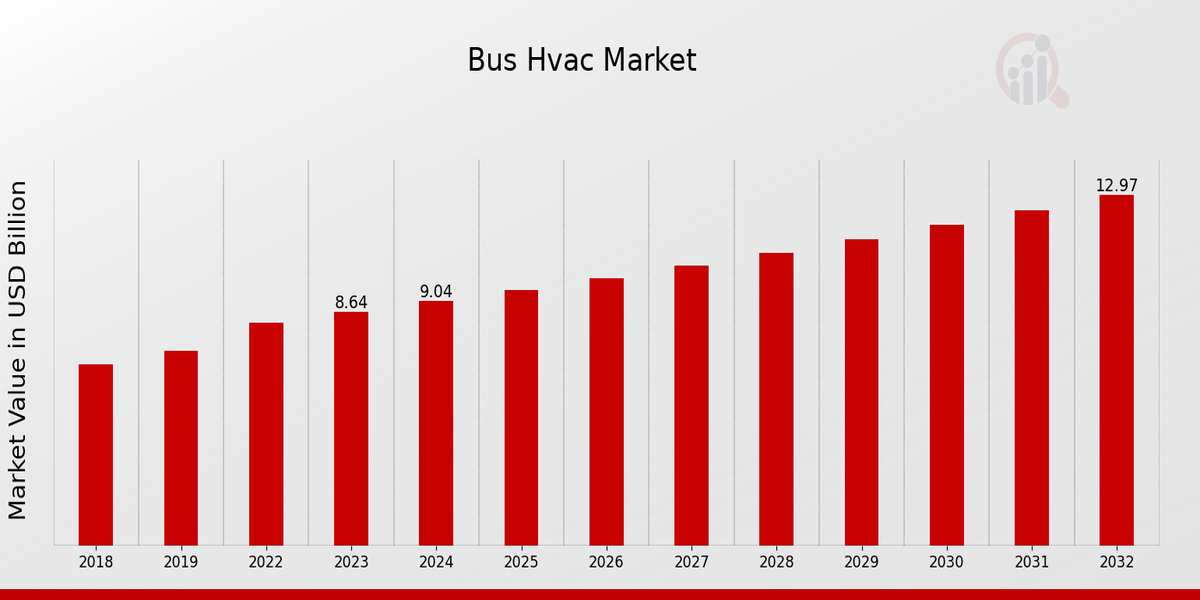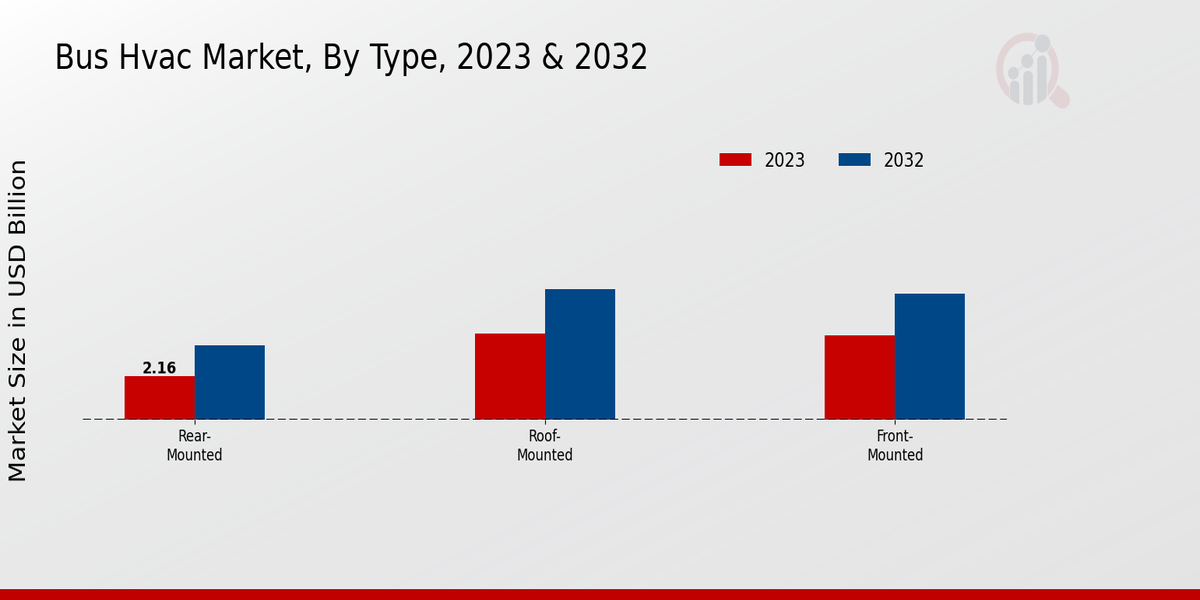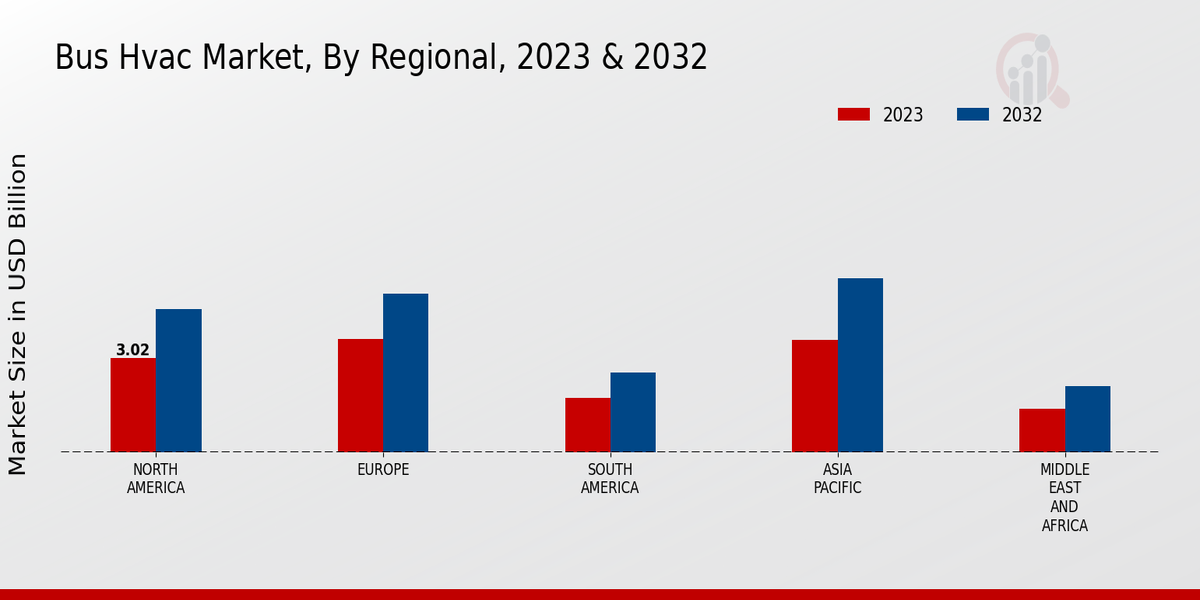Bus HVAC Market Overview:
As per MRFR analysis, the bus HVAC market size was estimated at 8.26 (USD Billion) in 2022. The bus HVAC market industry is expected to grow from 8.64 (USD Billion) in 2023 to 12.97 (USD Billion) by 2032. The bus HVAC market CAGR (growth rate) is expected to be around 4.62% during the forecast period (2024-2032).
Key Bus HVAC Market Trends Highlighted
The global bus HVAC market is expanding due to rising demand for improved passenger comfort, especially in emerging markets. Stringent government regulations on vehicle emissions and fuel efficiency are driving the adoption of energy-efficient HVAC systems. Additionally, technological advancements, such as electric buses and autonomous driving, are creating opportunities for integrated HVAC solutions.
The integration of IoT and remote monitoring systems allows real-time tracking and optimization of HVAC performance. OEMs are partnering with technology providers to develop innovative solutions, while aftermarket players focus on providing maintenance and replacement services. By addressing these trends and market drivers, businesses can capture opportunities in the growing bus HVAC market.

Source: Primary Research, Secondary Research, MRFR Database and Analyst Review
Bus HVAC Market Drivers
Rising Demand for Enhanced Passenger Comfort
The increasing demand for enhanced passenger comfort is a key driver of the Global Bus HVAC Market. As buses become more advanced and sophisticated, passengers are demanding more comfortable and convenient travel experiences.
This is leading to a growing demand for HVAC systems that can provide optimal temperature control, air quality, and noise reduction. HVAC systems play a crucial role in maintaining a comfortable cabin environment, especially during extreme weather conditions.
They ensure that passengers can travel in a pleasant and comfortable atmosphere, which enhances their overall travel experience. As a result, bus manufacturers are increasingly focusing on installing advanced HVAC systems to meet the evolving needs of passengers and stay competitive in the market.
Growing Adoption of Electric and Hybrid Buses
The growing adoption of electric and hybrid buses is another major driver of the Global Bus HVAC Market. Electric and hybrid buses require specialized HVAC systems that can meet their unique cooling and heating requirements. These systems must be able to efficiently manage the heat generated by the electrical components and batteries, while also providing a comfortable environment for passengers.
As the adoption of electric and hybrid buses continues to increase, the demand for specialized HVAC systems will also rise. This is creating new opportunities for manufacturers and suppliers in the HVAC market.
Stringent Environmental Regulations
Stringent environmental regulations are also driving the growth of the Global Bus HVAC Market. Governments worldwide are implementing stricter regulations to reduce emissions and improve air quality. This is leading to a growing demand for HVAC systems that are more energy-efficient and environmentally friendly.
HVAC manufacturers are responding to these regulations by developing new technologies that reduce energy consumption and emissions. For instance, they are focusing on improving the efficiency of compressors and fans, using low-GWP refrigerants, and incorporating advanced control systems.
Bus HVAC Market Segment Insights:
Bus HVAC Market Type Insights
The global bus HVAC market is segmented by type into roof-mounted, front-mounted, and rear-mounted. The roof-mounted segment held the largest market share in 2023, accounting for over 42% of the market revenue.
The front-mounted segment is expected to grow at the highest CAGR during the forecast period, owing to the increasing demand for buses with improved fuel efficiency and reduced emissions. The Rear-Mounted segment is expected to hold a significant market share during the forecast period, due to its wide application in school buses and public transportation buses.

Source: Primary Research, Secondary Research, MRFR Database and Analyst Review
Bus HVAC Market Fuel Type Insights
The global bus HVAC market is segmented by fuel type into diesel, electric, and hybrid. The diesel segment is expected to hold the largest market share in 2023, accounting for over 60% of the total revenue. The dominance of diesel vehicles in the commercial transportation sector, including buses, is primarily due to their high fuel efficiency and cost-effectiveness compared to other fuel types. However, growing environmental concerns and government regulations aimed at reducing emissions are expected to drive the adoption of electric and hybrid buses in the coming years.
The electric bus segment is projected to witness significant growth, with a CAGR of over 10%, during the forecast period 2024-2032, owing to government initiatives promoting zero-emission transportation and advancements in battery technology.
Hybrid buses, which combine both diesel and electric powertrains, offer a balance between fuel efficiency and environmental friendliness, and are expected to gain traction in regions with stringent emission regulations.
Bus HVAC Market Bus Size Insights
The bus size segment is a key factor in the global bus HVAC market, and it is expected to grow significantly over the forecast period. In 2023, the small (3-12 meters) bus size segment accounted for the largest share of the market, and it is expected to continue to dominate the market throughout the forecast period.
The medium (13-18 meters) bus size segment is expected to grow at a significant rate over the forecast period, due to the increasing demand for public transportation in urban areas. The large (19+ meters) bus size segment is expected to grow at a slower rate than the other segments, due to the higher cost of these buses.
Bus HVAC Market Cooling Capacity Insights
The cooling capacity segment of the global bus HVAC market is anticipated to exhibit significant growth in the coming years. In 2023, the below 20 TR segment accounted for the largest revenue share, owing to the high demand for buses with smaller cooling capacities.
The 20-40 TR segment is expected to witness the highest growth rate during the forecast period, driven by the increasing adoption of electric buses and the need for higher cooling capacities. The 40-60 TR and above 60 TR segments are also expected to grow at a steady pace, as manufacturers focus on developing more efficient and powerful HVAC systems for larger buses.
Bus HVAC Market Application Insights
The application segment is a crucial aspect of the global bus HVAC market. City buses emerged as the dominant segment, capturing a significant market share in 2023. These buses operate in urban areas with high passenger traffic, necessitating efficient climate control systems to ensure passenger comfort.
School buses are another important segment, with growing demand driven by increasing enrollment rates and government regulations mandating comfortable learning environments. Airport shuttles and tour coaches also contribute to the market growth, as they require HVAC systems to maintain a comfortable temperature during long journeys and frequent passenger turnover.
Bus HVAC Market Regional Insights
The global bus HVAC market is expected to reach a valuation of USD 12.97 billion by 2032, exhibiting a CAGR of 4.62% during the forecast period (2024-2032). North America held the largest revenue share in 2023, accounting for over 35% of the global bus HVAC market. The rapid adoption of advanced technologies and stringent regulations pertaining to passenger comfort and safety are key factors driving growth in this region.
Europe is another significant market, with a revenue share of around 28% in 2023. The presence of leading bus manufacturers and government initiatives promoting sustainable transportation contribute to the growth of the market in Europe. APAC is projected to witness the highest CAGR during the forecast period, owing to increasing urbanization, rising disposable income, and government investments in public transportation infrastructure.

Source: Primary Research, Secondary Research, MRFR Database and Analyst Review
Bus HVAC Market Key Players and Competitive Insights:
Major players are constantly investing in research and development to improve their product offerings and gain a competitive edge. Leading bus HVAC market players are also focusing on expanding their global presence and establishing partnerships with local players to increase their market share. The market is characterized by intense competition, and companies are adopting various strategies to differentiate their products and services.
These strategies include offering customized solutions, providing value-added services, and leveraging technology to enhance product performance and efficiency. Moreover, the Bus HVAC Market is witnessing the emergence of new players, who are bringing innovative solutions and disrupting the market landscape.
Valeo is a leading player in the market. The company offers a wide range of products and solutions for the bus industry, including air conditioning systems, heating systems, and ventilation systems. Valeo has a strong global presence and operates in over 30 countries.
The company's focus on innovation and customer satisfaction has helped it to maintain its leadership position in the market. Valeo is committed to developing sustainable solutions that meet the needs of the bus industry and its customers.
Another key player is Eberspächer. The company is headquartered in Germany and has a global presence in over 80 countries. Eberspächer offers a wide range of products and solutions for the bus industry, including air conditioning systems, heating systems, and exhaust systems. The company is known for its high-quality products and its focus on customer service.
Eberspächer is committed to developing innovative solutions that meet the needs of the bus industry and its customers. The company's strong global presence and commitment to innovation have helped it to become a leading player in the market.
Key Companies in the Bus HVAC Market Include:
- Spheros
- Eberspaecher
- CAREL Industries
- Donghee Industrial
- Modine Manufacturing
- Edscha Group
- Denso Corporation
- Mahle GmbH
- Kyungshin
- Dongyang Air Conditioning Co.
- Sangsin Brake Co.
- KonvektaAG
- Thermo King
- Hanon Systems
- Valeo
Bus HVAC Market Developments
The global bus HVAC market is projected to reach USD 12.97 billion by 2032, exhibiting a CAGR of 4.62% from 2024 to 2032. Rising demand for comfortable and energy-efficient transportation, coupled with increasing government regulations on vehicle emissions, are major factors driving market growth. Additionally, advancements in HVAC technologies, such as electric compressors and refrigerant alternatives, are enhancing the market's prospects.
Key industry participants include Carrier, Thermo King, and Valeo, who are focusing on product innovation and strategic partnerships to maintain their competitive edge. Recent developments include the integration of IoT and telematics systems for remote monitoring and diagnostics, as well as the adoption of sustainable refrigerants to reduce environmental impact.
Bus HVAC Market Segmentation Insights
Bus HVAC Market Type Outlook
- Roof-Mounted
- Front-Mounted
- Rear-Mounted
Bus HVAC Market Fuel Type Outlook
Bus HVAC Market Bus Size Outlook
- Small (3-12 meters)
- Medium (13-18 meters)
- Large (19+ meters)
Bus HVAC Market Cooling Capacity Outlook
- Below 20 TR
- 20-40 TR
- 40-60 TR
- Above 60 TR
Bus HVAC Market Application Outlook
- City Buses
- School Buses
- Airport Shuttles
- Tour Coaches
Bus HVAC Market Regional Outlook
- North America
- Europe
- South America
- Asia Pacific
Middle East and Africa
| Report Attribute/Metric |
Details |
| Market Size 2022 |
8.26 (USD Billion) |
| Market Size 2023 |
8.64 (USD Billion) |
| Market Size 2032 |
12.97 (USD Billion) |
| Compound Annual Growth Rate (CAGR) |
4.62% (2024-2032) |
| Report Coverage |
Revenue Forecast, Competitive Landscape, Growth Factors, and Trends |
| Base Year |
2023 |
| Market Forecast Period |
2024-2032 |
| Historical Data |
2019-2023 |
| Market Forecast Units |
USD Billion |
| Key Companies Profiled |
Spheros, Eberspaecher, CAREL Industries, Donghee Industrial, Modine Manufacturing, Edscha Group, Denso Corporation, Mahle GmbH, Kyungshin, Dongyang Air Conditioning Co., Sangsin Brake Co., KonvektaAG, Thermo King, Hanon Systems, Valeo |
| Segments Covered |
Type, Fuel Type, Bus Size, Cooling Capacity, Application, Region |
| Key Market Opportunities |
1. Rising demand for electric buses 2. Increasing government regulation on emission control 3. Technological advancements in air conditioning systems 4. Expanding public transportation 5. Growing demand in developing countries |
| Key Market Dynamics |
1. Increasing bus electrification 2. Growing demand for passenger comfort 3. Stringent emission regulations 4. Advanced technologies integration 5. Rise of electric buses |
| Countries Covered |
North America, Europe, APAC, South America, MEA |
Frequently Asked Questions (FAQ) :
The global bus HVAC market was valued at USD 8.64 billion in 2023.
The global bus HVAC market will grow at a CAGR of 4.62% from 2024 to 2032.
The Global Bus HVAC Market is expected to reach a value of USD 12.97 billion by 2032.
Asia Pacific is expected to dominate the global bus HVAC market throughout the forecast period.
Rising demand for comfortable bus journeys, increasing urbanization, and government regulations on vehicle emissions are driving growth.

















